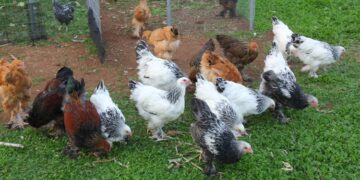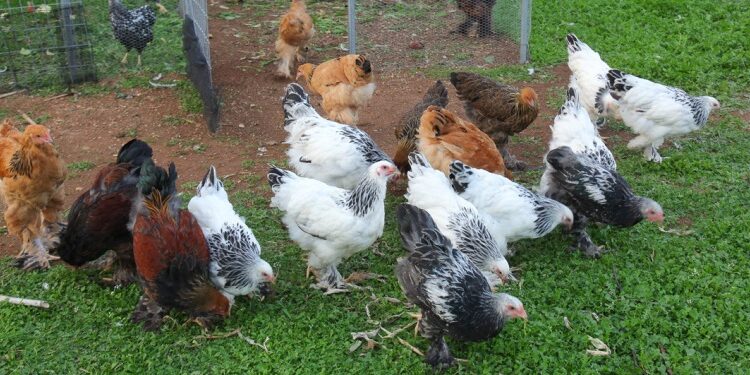Τι φοβούνται επιστήμονες – Τι ακριβώς είναι
Το τελευταίο διάστημα παρατηρείται ραγδαία αύξηση κρουσμάτων γρίπης των πτηνών υψηλής παθογονικότητας (κυρίως ο υπότυπος Η5Ν1) σε χώρες της βόρειας και κεντρικής Ευρώπης ((Ιταλία, Γερμανία, Δανία, Ολλανδία, Ουγγαρία, Πολωνία, Τσεχία, Σλοβακία, Ιρλανδία), ενώ κρούσματα έχουν εντοπιστεί και στην ελληνική επικράτεια, αλλά και στη γειτονική Βουλγαρία.
Στις περισσότερες περιπτώσεις τα κρούσματα έχουν εντοπιστεί σε άγρια πτηνά, όμως η εικόνα στην Ευρώπη θυμίζει παλαιότερα επιδημικά κύματα, με αποτέλεσμα να έχει προκληθεί ανησυχία στους ειδικούς, οι οποίοι έχουν συστήσει την πιστή εφαρμογή της σχετικής Απόφασης του Υπουργείου Αγροτικής Ανάπτυξης και Τροφίμων για τη «Θέσπιση μέτρων βιοασφάλειας για τη γρίπη των πτηνών».
Τι είναι, όμως, αυτό που προκαλεί ανησυχία στους ειδικούς και τι θα πρέπει να ξέρουμε για το συγκεκριμένο είδος γρίπης;
Τι ακριβώς είναι η γρίπη των πτηνών
Πρόκειται για μια λοιμώδη ζωονόσο, η οποία προκαλείται από έναν ιό που είναι «μακρινός συγγενής» της γρίπης που προσβάλλει τον άνθρωπο. Ορισμένα στελέχη της μπορούν να μεταδοθούν σε ανθρώπους, όμως αυτό είναι πολύ σπάνιο και συνήθως συμβαίνει μέσω της πολύ στενής επαφής με μολυσμένα πτηνά ή άλλα ζώα. Αν και θεωρείται ότι όλα τα είδη των πτηνών και, σπανιότερα, οι χοίροι είναι ευάλωτοι στη νόσο, τα εκτρεφόμενα πουλερικά κινδυνεύουν περισσότερο. Οι εξάρσεις της νόσου μπορούν να προκαλέσουν ραγδαία επιδημίες μεταξύ των πληθυσμών των πτηνών. Οι δημόσιες υγειονομικές αρχές ανησυχούν για το ενδεχόμενο ο ιός να μεταλλαχθεί σε υπότυπους, ικανούς να προκαλέσουν ασθένεια σε ανθρώπους. Ως αποτέλεσμα, προειδοποιούν ότι πάντα υφίσταται η απειλή ανάδυσης μιας νέας γρίπης ικανής να προκαλέσει πανδημία.
Γιατί ακούμε ξανά για αυτή;
Πέραν του κρούσματος στον Έβρο, που έχει προκαλέσει ανησυχία στους ειδικούς, η γρίπη των πτηνών έχει κάνει την εμφάνισή της και σε άλλες περιοχές της Ευρώπης. Στη Βρετανία, μάλιστα, οδήγησε στη σφαγή 500.000 πουλερικών, μετά από έξαρση-ρεκόρ σε ορνιθοτροφεία.
Ποια είναι τα πιο επικίνδυνα στελέχη;
Υπάρχουν τέσσερα στελέχη που έχουν προκαλέσει ανησυχία στη διάρκεια των τελευταίων ετών. Το πρώτο, που εντοπίστηκε το 1997, ήταν η Η5Ν1, ενώ ακολούθησαν η Η7Ν5 το 2013, η Η5Ν6 το 2014 και η Η5Ν8 το 2016. Η Η5Ν1 είναι η πλέον ανησυχητική παραλλαγή του ιού, ενώ φέτος εντοπίστηκε σε πουλερικά στη Βρετανία.
Αν μεταδίδεται μόνο σε πτηνά, γιατί μας ανησυχεί;
Γιατί δεν μεταδίδεται μόνο σε πτηνά. Στοιχεία του ΠΟΥ δείχνουν ότι από το 2003 έως το 2021 καταγράφηκαν 863 επιβεβαιωμένα κρούσματα της Η5Ν1 σε ανθρώπους. Από αυτούς, οι 456 έχασαν τη ζωή τους.
Μέχρι στιγμής, οι περισσότεροι θάνατοι ανθρώπων καταγράφηκαν σε χώρες της Ασίας και σε κοινότητες εντός των οποίων άνθρωποι και πουλερικά ζούσαν σε πολύ στενή επαφή. Παρά το γεγονός ότι δεν μεταδίδεται εύκολα σε ανθρώπους, κάθε φορά που αυτό συμβαίνει, αυξάνονται και οι πιθανότητες μετάλλαξης του ιού σε μορφή που θα μπορούσε να μεταδοθεί από άνθρωπο σε άνθρωπο. Ο ΠΟΥ φοβάται ότι κάτι τέτοιο θα οδηγούσε σε πανδημία γρίπης.
Πώς κολλάει κανείς γρίπη των πτηνών;
Είναι αρκετά απίθανο να συμβεί, εκτός αν κάποιος βρεθεί σε στενή επαφή με μολυσμένα πτηνά ή με κάποιο επιβεβαιωμένο ή ύποπτο κρούσμα γρίπης των πτηνών. Ο ιός εντοπίζεται στις εκκρίσεις των ματιών καθώς επίσης και στην αναπνευστική οδό και τις απεκκρίσεις των μολυσμένων πτηνών. Οι άνθρωποι μπορούν να κολλήσουν τον ιό εισπνέοντας σταγονίδια από τα φτερνίσματα των μολυσμένων πτηνών ή από τη σκόνη που εκλύεται από τις φωλιές και τις απεκκρίσεις τους.
Ποια είναι τα συμπτώματα στον άνθρωπο;
Εξαρτώνται από το στέλεχος. Στις περισσότερες περιπτώσεις θυμίζουν τα συμπτώματα της κοινής γρίπης, συμπεριλαμβανομένου του πυρετού, του βήχα, του ερεθισμένου λαιμού, της καταρροής και των μυϊκών πόνων. Τα συμπτώματα του υπότυπου Η5Ν1 είναι πιο σφοδρά και σε πολλές περιπτώσεις καταλήγουν στο θάνατο. Στα συμπτώματα περιλαμβάνεται και η επιπεφυκίτιδα.
Πώς εξαπλώνεται;
Επιστήμονες του ΠΟΥ έχουν αναφέρει ότι εκτιμούν πως ο ιός μεταφέρεται από τα αποδημητικά πτηνά. Πιο πρόσφατα, η βρετανική κυβέρνηση έχει δηλώσει ότι «εξαπλώνεται από το ένα πτηνό στο άλλο μέσω άμεσης επαφής ή μολυσμένων σωματικών υγρών και απεκκρίσεων». Οι αρχές της Βρετανίας είχαν προσθέσει ότι μπορεί να μεταδοθεί και από μολυσμένη τροφή και νερό ή βρώμικα οχήματα, ρούχα και υποδήματα, σημειώνοντας ότι δεν πρόκειται για νόσο που μεταδίδεται μέσω του αέρα.
Οι άνθρωποι μπορούν να προσβληθούν αν έρθουν σε επαφή με τα ίδια τα μολυσμένα πτηνά, τις απεκκρίσεις ή τη φωλιά τους ή αν σκοτώσουν ή προετοιμάσουν μολυσμένα πτηνά για να τα μαγειρέψουν, σύμφωνα με το βρετανικό δημόσιο σύστημα υγείας. Η νόσος δεν μεταδίδεται από την κατανάλωση καλά μαγειρεμένων πουλερικών ή των αυγών τους, ακόμη και σε περιοχές που βιώνουν έξαρση.
Πώς μπορείς να καταλάβεις αν ένα πτηνό φέρει τον ιό;
Τα συμπτώματα των μολυσμένων πτηνών περιλαμβάνουν οίδημα της κεφαλής και την εμφάνιση ενός μπλε σημαδιού γύρω από το λαιμό και τον αυχένα. Επιπλέον, εμφανίζουν συμπτώματα αναπνευστικής δυσκολίας, για παράδειγμα μπορεί να ανοιγοκλείνουν τα ράμφη τους, να βήχουν, να φτερνίζονται ή να ακούγεται συριγμός κατά την αναπνοή τους. Οι ορνιθοτρόφοι μπορεί να παρατηρήσουν επίσης απώλεια όρεξης για φαγητό στα πτηνά τους καθώς και μείωση των αυγών τους.
Οι ειδικοί συστήνουν να μην αγγίζουμε και να μην περισυλλέγουμε νεκρά ή εμφανώς ασθενή πτηνά που εντοπίζουμε.
Υπάρχει φάρμακο για τους ανθρώπους;
Δεν υπάρχει εμβόλιο για τη γρίπη των πτηνών. Αν κάποιος μολυνθεί, του χορηγείται αγωγή με κάποιο αντιικό φάρμακο, όπως το Tamiflu ή το Relenza.
Οι επιστήμονες έχουν διαπιστώσει ότι αυτού του είδους οι θεραπείες «μπορούν να συμβάλουν στη μείωση της σφοδρότητας της κατάστασης, να αποτρέψουν επιπλοκές και να βελτιώσουν την πιθανότητα ανάρρωσης. Επιπλέον, ορισμένες φορές χορηγούνται προληπτικά σε ανθρώπους που έχουν έρθει σε στενή επαφή με τα μολυσμένα πτηνά ή σε εκείνους που έχουν έρθει σε επαφή με μολυσμένους ανθρώπους, για παράδειγμα σε συγγενείς και επαγγελματίες υγείας», σύμφωνα με το NHS.
Με πληροφορίες από Guardian, in.gr































